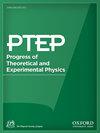扭转和物质耦合引力中的带电球面解以及扭转参数和电荷对低质量间隙紧凑恒星的影响
IF 8.3
4区 物理与天体物理
Q1 Physics and Astronomy
引用次数: 0
摘要
在本研究中,我们探讨了带电球面模型的新精确解,以及在$f(\mathcal {T})$引力框架下,扭转参数χ1和电荷Q对低质量间隙紧凑恒星的天体物理学影响。从描述各向异性物质分布的场方程开始,我们为度量函数的径向分量选择了一个良好的解析,并为电场选择了一个适当的公式。由此产生的模型要经过严格的测试,以确保它在 $f(\mathcal {T})$ 引力背景下是一个物理上可行的紧凑物体。我们广泛研究了两个因素:χ1和Q,仔细分析它们对恒星质量、半径和稳定性的影响。我们的分析表明,我们的模型表现出良好的行为,没有奇点,可以成功地解释大量观测到的紧凑天体的存在。这些天体的质量从$0.85^{+0.15}_{-0.15}$到2.67 M⊙不等,其中上限值属于在GW190814等引力事件中观测到的质量差距范围。这项研究的一个显著发现有两个方面:我们观察到这些天体的最大质量(Mmax)和相应半径受到了显著影响。χ1值的增加会导致更大的最大质量(Mmax)(约为2.64^{+0.13}_{-0.14}$)和更小的半径(约为10.40^{+0.16}_{-0.60}$),这表明系统中可能存在大质量中子星(NSs)。相反,Q 值的增大会导致 Mmax 值的减小(约为 1.70^{+0.05}_{-0.03}$)和半径的增大(约为 13.71^{+0.19}_{-0.20}$)。此外,比较这些结果还发现了一个有趣的现象:在所有的χ1值下,非旋转恒星的质量都比慢旋转恒星的质量大,而在调整Q值时,这一趋势却发生了逆转。本文章由计算机程序翻译,如有差异,请以英文原文为准。
Charged spherical solution in torsion and matter coupling gravity and influence of torsion parameter and electric charge on compact stars in lower mass gap
In this study, we explore a new exact solution for a charged spherical model as well as the astrophysical implications of the torsion parameter χ1 and electric charge Q on compact stars in lower mass gaps in the $f(\mathcal {T})$ gravity framework. Commencing with the field equations that describe anisotropic matter distributions, we select a well-behaved ansatz for the radial component of the metric function, along with an appropriate formulation for the electric field. The resulting model undergoes rigorous testing to ensure its qualification as a physically viable compact object within the $f(\mathcal {T})$ gravity background. We extensively investigate two factors: χ1 and Q, carefully analyzing their impacts on the mass, radius, and stability of the star. Our analyses demonstrate that our models exhibit well-behaved behavior, free from singularities, and can successfully explain the existence of a wide range of observed compact objects. These objects have masses ranging from $0.85^{+0.15}_{-0.15}$ to 2.67 M⊙, with the upper value falling within the mass gap regime observed in gravitational events like GW190814. A notable finding of this study has two aspects: we observe significant effects on the maximum mass (Mmax) and the corresponding radii of these objects. Increasing values of χ1 lead to higher Mmax (approximately $2.64^{+0.13}_{-0.14}$) and smaller radii (approximately $10.40^{+0.16}_{-0.60}$), suggesting the possibility of the existence of massive neutron stars (NSs) within the system. Conversely, increasing values of Q result in a decrease in Mmax (approximately $1.70^{+0.05}_{-0.03}$) and larger radii (approximately $13.71^{+0.19}_{-0.20}$). Furthermore, an intriguing observation arises from comparing the results: for all values of χ1, non-rotating stars possess higher masses compared to slow-rotating stars, while this trend is reversed when adjusting Q.
求助全文
通过发布文献求助,成功后即可免费获取论文全文。
去求助
来源期刊

Progress of Theoretical and Experimental Physics
PHYSICS, MULTIDISCIPLINARY-PHYSICS, PARTICLES & FIELDS
CiteScore
12.00
自引率
5.70%
发文量
148
审稿时长
17 weeks
期刊介绍:
Progress of Theoretical and Experimental Physics (PTEP) is an international journal that publishes articles on theoretical and experimental physics. PTEP is a fully open access, online-only journal published by the Physical Society of Japan.
PTEP is the successor to Progress of Theoretical Physics (PTP), which terminated in December 2012 and merged into PTEP in January 2013.
PTP was founded in 1946 by Hideki Yukawa, the first Japanese Nobel Laureate. PTEP, the successor journal to PTP, has a broader scope than that of PTP covering both theoretical and experimental physics.
PTEP mainly covers areas including particles and fields, nuclear physics, astrophysics and cosmology, beam physics and instrumentation, and general and mathematical physics.
 求助内容:
求助内容: 应助结果提醒方式:
应助结果提醒方式:


